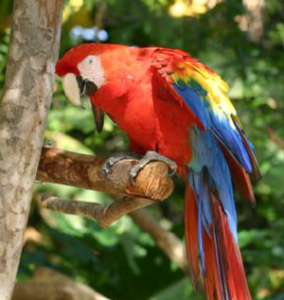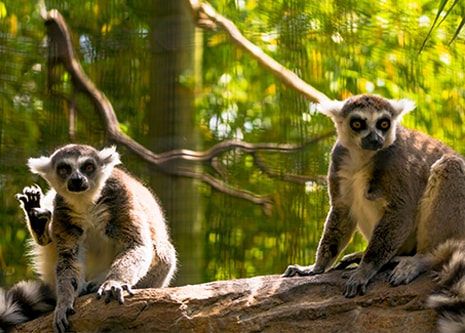
- VisitSupport Happy HollowDONATE TODAYExploreSupport Happy HollowDONATE TODAYLearnSupport Happy HollowDONATE TODAYSupport
-
Today's Hours: 10:00 am to 5:00 pm
Zoo in the HollowScarlet macaw

Scientific Name: Ara macao
Family: Psittacidae
Order: Psittaciformes
Class: Aves
Range: Central and South America
Habitat: Tropical rainforests, woodlands, grasslands
Lifespan: 40 to 50 years on average; up to 75 years in captivityWhat do they look like?
Scarlet macaws typically weigh about two pounds and are 32 inches long, more than half of which is their tail. Their faces are mostly bare with small red feathers making different patterns for each individual. Their lower beak is black, while their upper beak is cream-colored. They also have four toes on each foot that are zygodactyl (two toes face forward two toes face backwards). Each toe has a long, sharp nail at the tip. They have vibrant red feathers covering their head, back, and tail. Their wings also have bands of yellow and blue.How do they behave?
Macaws are very social birds. In the wild, they live in large families or colonies called flocks. These flocks can have between 10 and 30 members. Members of the flock will often forage together for food and sometimes allopreen (groom) each other to form stronger bonds. Scarlet macaws make a range of vocalizations to communicate with members of their flock. Their vocalizations are often loud because they need to carry over the other sounds of the rainforest. These animals are diurnal (mostly active during the daytime), and they will generally find a tree to sleep in with their flock at night.What do they eat?
Macaws eat mostly fruits, seeds, and nuts. They may also feed on nectar and flower buds. They have been observed gathering at clay licks, which provide high levels of sodium. Some foods are toxic to these parrots, such as cherries and avocados. At Happy Hollow, they eat fruit, vegetables, greens, seeds, nuts, a specialized parrot food, and vitamin supplements.How are they born?
Macaws are typically monogamous, with the mating season lasting 6-8 weeks in the spring. The female nests in a tree cavity and lays 2-3 eggs. She incubates the eggs for approximately five weeks. Chicks hatch with pink skin and little to no feathers. Until they grow their first down feathers for warmth and protection, the female will stay close to keep them safe and comfortable. Chicks fledge (start to fly) from the nest about 90 days after hatching.Conservation
The scarlet macaw’s conservation status is currently listed as Least Concern by the International Union for Conservation of Nature (IUCN). While scarlet macaws aren’t an endangered species at this time, they are still at risk due to a combination of factors. They face habitat loss through deforestation, and capture from the wild for pet trade. One organization focusing on macaw conservation is the World Wildlife Fund (WWF). WWF aims to preserve the vital rainforest habitat that macaws call home. You can help scarlet macaws by leaving these beautiful birds in the wild, rather than keeping them as pets. The pet trade is listed as one of the main reason their population is decreasing. Due to large spatial needs and social interaction, these birds are much better suited for life in the wild. If you are looking for a new pet, check out your local humane society, there you will find people who can help you make the proper pet choice.
Zoo on the Hill
Located across from the Keep-Around Carousel is the Zoo on the Hill. Learn about wildlife up close during daily meet-and-greets, leap like a lemur on the playground, brush and feed the goats,, or take a peek inside Doc’s Critter Care building and the Ranch House. Double-H Ranch features a combination of animal exhibits, including giant anteaters and red ruffed lemurs, as well chickens and domesticated animals that are docile enough to touch.
See Animals
Education Ambassadors
From camps and classes to scout badges and sleepovers, Happy Hollow education programs have something for everyone! The zoo education program offers a broad range of hands-on, engaging programs and public presentations featuring education ambassador animals. These encounters are designed to connect you to wildlife and the conservation of their habitats around the world.
See AnimalsVisit Us Today
Plan an unforgettable experience at San Jose’s family-friendly park and zoo.
Learn More